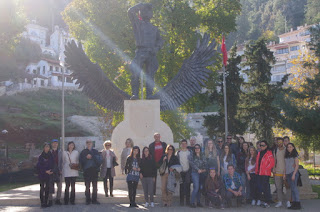On the17th of December we visited Xantos.
Xantos was the name of a city in ancient Lycia in Turkey. Tlos lies on the east side of the Xanthos valley.
At the top of the hill sits the remains of an acropolis and a Lycian fortress, which is evident by the remains of a Lycian wall and Roman-era wall. The Ottomans constructed a fort for the local feudal governor Kanlı Ağı Ali (Bloody Chief Ali) upon the foundations of the fortress.
Since early Lycian times, the city's settlement was likely concentrated on the southern and western slopes. Wide terraces with cisterns and the back walls of buildings carved from the rock are found there, as well as an agora, a Roman-era amphitheatre, baths and the remains of a Byzantine church.
At the foot of the hill is a Roman stadium with seating capacity for 2,500 people. Only the seats remain and the arena is a farmer's field. Granite columns were strewn about the area, which could indicate a columned portico on the north side of the arena.
Inscriptions reveal that citizens of Tlos were divided into demes (social subdivisions), the names of three of them are known: Bellerophon, Iobates and Sarpedon, famous Lycian heroes of legend. A Jewish community is also known to have existed with its own magistrates.
Tlos was rediscovered by Charles Fellows in 1838 and he was followed by the explorer Thomas Abel Brimage Spratt, who thought that "a grander site for a great city could scarcely have been selected in all Lycia."
Picture from; www.theoi.com
In mythology, it was the city inhabited by hero Bellerophon and his winged flying horse Pegasus. It is known that the king-type tomb in the necropolis is dedicated to Bellerophon.
On the opposite hill top, the village of Yaka now co-exists with Tlos. Fields and pomegranate trees make for very picturesque scenery. Tlos is a popular destination for tourist from the coastal town such as Kas and Kalkan.
Doris Kirn 1.D




























